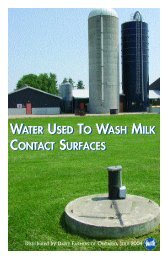Canadian Quality Milk On-Farm Food Safety Program - Centre ...
Canadian Quality Milk On-Farm Food Safety Program - Centre ...
Canadian Quality Milk On-Farm Food Safety Program - Centre ...
You also want an ePaper? Increase the reach of your titles
YUMPU automatically turns print PDFs into web optimized ePapers that Google loves.
<strong>Canadian</strong> <strong>Quality</strong> <strong>Milk</strong><br />
Check that the receiver jar, pipeline, weigh jars, milk hoses and other potential<br />
areas where water could collect are fully drained. This will ensure water is not<br />
being added accidentally to the milk and affecting the freezing point, and that<br />
cleaning or sanitizing chemicals are not being added to milk.<br />
Install a milk filter. To maintain the effectiveness<br />
of keeping out bacteria and debris, the milk filter<br />
should be replaced before or after each cleaning as<br />
determined by milking equipment manufacturer’s<br />
recommendations.<br />
Move the milk delivery line (transfer pipe) from<br />
the wash sink over to the bulk tank. With the<br />
safety switch in place, this allows milking<br />
equipment to be operational and stops milk from<br />
accidentally going down the drain.<br />
Put the wash diverter valve into the ‘milking’ position. This will allow milk from<br />
both sides of the milkline to flow by gravity to the receiver jar.<br />
Verify teat dip container(s) is/are clean and ready for use. This will ensure an<br />
adequate amount of dip available for milking, and reduce the spread of contagious<br />
diseases to cows/heifers.<br />
Follow label directions when preparing the udder wash solution. The proper<br />
concentration is necessary to kill bacteria.<br />
Set udder wash water temperature. Follow the product recommended<br />
temperature range to insure effective use of the product.<br />
Check supply of single-service towels. Restock if necessary. You should not run<br />
out of towels, or reusable cloth towels, during milking, and you should never reuse<br />
disposable towels. Contagious diseases can be spread this way.<br />
Prepare the treated animal milking units, if there are treated lactating animals or<br />
animals with milk unfit for human consumption.<br />
Switch on the vacuum pump and check vacuum level on the vacuum gauge.<br />
Establish the normal vacuum range SOP for equipment set-up. Refer to the Chapter<br />
11 for guidelines on solving common equipment problems.<br />
If the tank is empty, turn on cooler when milk reaches agitator. This will ensure<br />
proper milk cooling without freezing. It will also slow bacteria growth and help<br />
prevent ‘malty’-flavoured milk. [Note: producers can include this required element in<br />
the SOP for milking instead of the SOP for pre-milking.]<br />
Wear disposable gloves. This can help reduce spread of contagious bacteria from<br />
animal to animal such as Staphylococcus aureus. Wearing disposable gloves can<br />
also help reduce spread of bacteria from the hands of the operator to raw milk.<br />
Close the doors when you leave the milk room. This keeps odours out to prevent<br />
‘barny’ or feed flavours in milk. This also prevents contamination from dust or dirt in<br />
June 2010 5—5
















